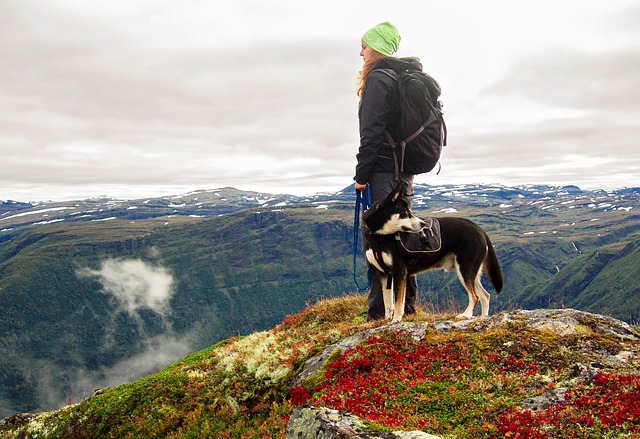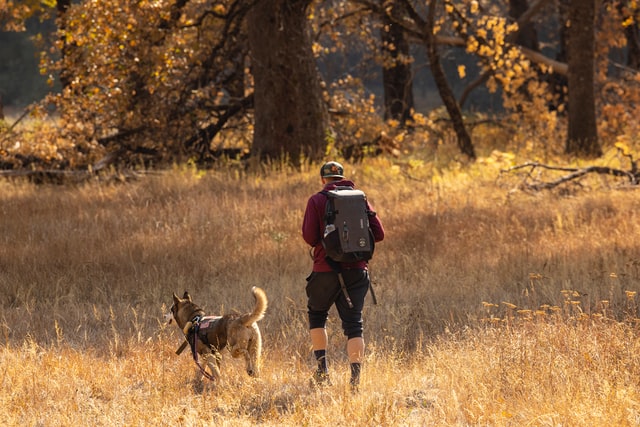Hiking with Dogs: Key Considerations
Posted: 11/06/2023 | BY: Erin Cain | Categories: Uncategorized
There’s a reason dogs are such popular hiking companions. Taking your dog hiking isn’t just great exercise for you and your furry friend, it’s also great motivation for you to keep going and really immerse yourself in the experience.
While hiking with dogs is beneficial for both the owner and the dog, it’s crucial to understand how to prepare for the journey so that it’s enjoyable and safe for your pup.
With that in mind, let’s look at the most important safety considerations when backpacking or hiking with your dog, the etiquette of taking dogs hiking, and how to avoid common hazards.

Safely Hiking with Dogs
When hiking, dogs can be excellent companions. But you need to consider their safety to ensure that you don’t put yourself, your dog, or anyone else at risk. Here are a few simple safety tips you should consider when hiking with your dog:
- Unless you’re in a very remote area with no dangerous wild animals, and unless your dog is well trained, it’s always a good idea to use a leash when hiking with dogs because it gives you more control over unexpected circumstances that might arise.
- You should also always carry a first-aid kit both for yourself and your dog. You never know what might happen in the middle of a hiking trail and you need to be able to stitch up a wound or apply a bandage so that you and your canine friend can safely go back for additional help.
- Another crucial consideration is whether your dog can handle the trip. We tend to think that dogs can go on forever with their seemingly limitless energy, but depending on the physical condition and age, your dog might need to be eased into longer hiking trips.
- Finally, no matter how short or easy you may believe the hike to be, it’s always best to have plenty of water for yourself and your dog. Hiking with your dog can quickly become dangerous if your pup is dehydrated and tired. Avoiding this requires taking regular breaks for water for both of you.
Backpacking with Your Dog: What Should I Bring?
If you want to take your dog for a longer thru-hike, you’ll need to know how to backpack with a dog in a way that’s safe and enjoyable for both of you. The good news is, even longer hiking trips with a dog are completely doable, as long as you prepare accordingly.
First off, consider your supplies. On shorter hikes, you may get by with water and snacks only, but backpacking with dogs means you’ll need to have plenty of food and water. And that means having bowls for both water and food that your dog can use when you stop to rest. Pro-tip: buy foldable bowls for easy space-saving in your pack.
If you’re going through rough terrain, you should also consider using paw protection for your dog, as you don’t want them to get injured and have to carry them out. Outdoor retailers offer various types of “shoes” that not only look adorable on your pup but are effective paw protectors as well.
Be sure to follow the rule: “Leave it better than you found it.” You should always have a way to collect waste so that you don’t leave anything behind and do not attract wild animals or ruin the experience for other hikers. And yes, you guessed it, this includes dog poop.
Finally, when hiking in unfamiliar wild areas, it’s a good idea to bring a leash as you can never predict whether wild animals, other dogs, or various hazards might be present.

How to Avoid Common Hazards While Taking Dogs Hiking
You and your dog’s safety should be your top priority during hikes. So it’s important to consider some of the most dangerous hazards you may face and have a plan to deal with them should they arise.
First off, when going on any hike with your dog, you should check the local area’s regulations and recommendations. Some areas might not allow dogs at all, while others might have mandatory requirements to keep dogs on a leash.
Before your trip, you should also look at the temperature forecast and consider whether it’ll be too hot or too cold for your pet to come along. If you’re going hiking during the summer months when it’s hot, make sure you take frequent breaks and provide your dog with clean water. Don’t forget, your pup is covered in thick fur and will overheat much faster than you.
Some of the most common issues dogs face on hikes are parasites and poisonous plants. Always inspect your dog for ticks and other parasites after the hike, and monitor your dog closely so that it doesn’t eat anything that could harm it.
Taking Your Dog Hiking: Etiquette Tips
Hiking with dogs can be a great deal of fun, but you still want to be mindful of how taking your dog with you impacts others. Not everyone loves dogs as much as you do. Just like regular hiking etiquette, it’s important to maintain good dog hiking etiquette so that you don’t have a negative impact on anyone else enjoying the hike.
The first thing you must do is find out if dogs are allowed in the first place. If not, simply choose a pet-friendly hiking alternative or go on this hike without your dog. Even if dogs are allowed, it’s a good idea to use a leash at all times as not all people are comfortable with a free-roaming dog.
Make sure that your dog is well-trained and knows how to interact with people and other animals. You don’t want to make anyone uncomfortable or worried about their own pets. Whether you’re hiking with small dogs or big dogs, be sure that they know how to interact with others — no matter what species they are.
When backpacking with a dog, don’t leave a trace and pick up everything your dog leaves behind. No one wants to step in a pile while on the trail.
Bottom Line
Hiking with dogs is a great outdoor activity but you must consider not just hiking etiquette, but also the safety of your canine buddies.
That’s why in addition to using the tips above, you should always get pet insurance that will protect your dog in case something happens — whether on the trail or off. At Pet Insurance Review, you can choose from a variety of providers and create a customized dog insurance plan that’s ideally suited for your needs. Get a quote today, and we’ll provide your four-legged friend with comprehensive coverage in no time!
Disclaimer
The information contained on this blog is intended for informational and educational purposes only and should not be construed as medical advice. It is not a substitute for professional veterinary care. Always consult with your veterinarian before making any changes to your pet's health care or treatment plan.
The authors of this blog are not veterinarians and do not claim to be experts in pet health. The information provided here is based on our own experiences and research, as well as information from reputable sources. However, we cannot guarantee the accuracy or completeness of this information.
We encourage you to do your own research and consult with your veterinarian before making any decisions about your pet's health.
Previous post
4 Reasons Your Kitten Needs Pet InsuranceNext post
Pet Regret: Post-Pandemic Pet PurchasesCompare top pet insurance providers & plans.
Enter your dog’s age in years and months to calculate their age equivalent to human years.
Calculate your dog’s ageEnter your cat’s age in years and months to calculate their age equivalent to human years.
Calculate your cat’s age